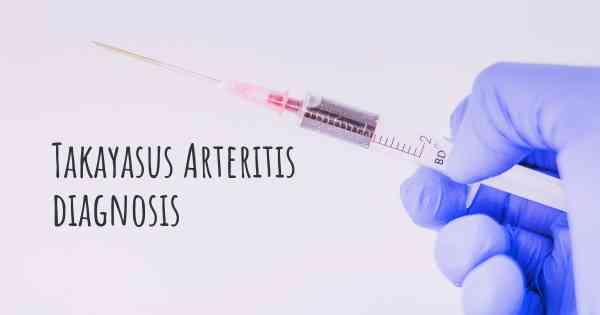How is Takayasus Arteritis diagnosed?
See how Takayasus Arteritis is diagnosed. Which specialists are essential to meet, what tests are needed and other useful information for the diagnosis of Takayasus Arteritis

Diagnosis of Takayasu's Arteritis
Takayasu's Arteritis (TA) is a rare chronic inflammatory disease that primarily affects the large blood vessels, particularly the aorta and its branches. It predominantly affects young women, typically between the ages of 15 and 40. Early diagnosis of TA is crucial to prevent complications and initiate appropriate treatment. The diagnosis of Takayasu's Arteritis involves a combination of clinical evaluation, imaging studies, and laboratory tests.
Clinical Evaluation
The initial step in diagnosing Takayasu's Arteritis involves a thorough clinical evaluation by a healthcare professional. The doctor will review the patient's medical history, including any symptoms experienced, family history of autoimmune diseases, and risk factors. The presence of specific symptoms associated with TA, such as fatigue, muscle pain, joint pain, fever, and unexplained weight loss, will be assessed. Physical examination may reveal signs such as weak or absent pulses, blood pressure differences between arms, and bruits (abnormal sounds) over the blood vessels.
Laboratory Tests
Laboratory tests are performed to assess the patient's overall health and to rule out other possible causes of symptoms. Although there is no specific blood test to confirm Takayasu's Arteritis, certain tests can provide supportive evidence. These tests include:
- Erythrocyte Sedimentation Rate (ESR) and C-Reactive Protein (CRP): Elevated levels of ESR and CRP indicate the presence of inflammation in the body, which can be suggestive of TA.
- Complete Blood Count (CBC): Abnormalities in the CBC, such as anemia or increased platelet count, may be observed in patients with TA.
- Autoantibodies: Testing for specific autoantibodies, such as antinuclear antibodies (ANA) and anti-neutrophil cytoplasmic antibodies (ANCA), can help rule out other autoimmune diseases that may present with similar symptoms.
Imaging Studies
Imaging studies play a crucial role in the diagnosis of Takayasu's Arteritis as they provide visual evidence of vascular abnormalities. The following imaging modalities are commonly used:
- Angiography: Conventional angiography involves injecting a contrast dye into the blood vessels and taking X-ray images. It helps visualize the narrowing, occlusion, or aneurysmal dilatation of the arteries, which are characteristic features of TA. However, angiography is an invasive procedure and may not be suitable for all patients.
- Magnetic Resonance Angiography (MRA): MRA uses magnetic fields and radio waves to create detailed images of the blood vessels. It is a non-invasive alternative to angiography and can provide valuable information about the extent and severity of arterial involvement in TA.
- Computed Tomography Angiography (CTA): CTA combines X-ray images with computer technology to produce detailed cross-sectional images of the blood vessels. It is particularly useful for assessing the aorta and its branches in patients with suspected TA.
- Ultrasound: Doppler ultrasound can be used to evaluate blood flow in the arteries and detect any abnormalities, such as stenosis or occlusion. It is a non-invasive and readily available imaging modality.
Diagnostic Criteria
The American College of Rheumatology (ACR) has established diagnostic criteria for Takayasu's Arteritis, which include:
- Age of onset 40 years or younger
- Weak or absent pulses in at least one limb
- Brachial artery systolic blood pressure difference >10 mmHg between arms
- Arteriographic evidence of narrowing or occlusion of the entire aorta, its primary branches, or large arteries in the proximal upper or lower extremities, not due to arteriosclerosis, fibromuscular dysplasia, or other causes
Meeting three or more of these criteria is highly suggestive of Takayasu's Arteritis.
Consultation with Specialists
Given the complexity of Takayasu's Arteritis, consultation with specialists, such as rheumatologists, vascular surgeons, or cardiologists, is often necessary for accurate diagnosis and management. These specialists have expertise in interpreting the clinical findings, laboratory results, and imaging studies to make an informed diagnosis.
Early diagnosis and prompt treatment are essential in Takayasu's Arteritis to prevent complications and improve outcomes. A comprehensive approach involving clinical evaluation, laboratory tests, imaging studies, and specialist consultation is crucial for accurate diagnosis.
Posted Mar 29, 2017 by Megan 1000
Posted Apr 16, 2017 by Audrina 800
Posted May 31, 2017 by Salosh 3601
Posted Sep 10, 2017 by Vandanaa Suran 1700
Posted Sep 11, 2017 by Taylor 2650
Posted May 17, 2018 by Noha nabil 900
Posted Sep 24, 2019 by lisa ainsworth 800
In the active disease usually normocytic / normochromic anaemia of chronic inflammatory process, thrombocytosis, hypergammaglobulinemia, polyclonal, increase of ESR and CRP. However, in the 25%-50% of cases these results can be misleading and do not correlate with disease activity, so that we will have to help us also of clinical data and testing imagenpara perform a comprehensive evaluation of each patient. Also, it has been described an increase of beta-2 microglobulin, IL-2, IL-6 , IL-8, IL-18, metalloprotease 3 and 9, and pentraxin-3 as biological markers of disease activity. Patients with ATK inactive have high serum levels of selectin-soluble E, molecule 1, vascular cell adhesion (VCAM - 1) and cell adhesion molecule-1 intercellular (ICAM-1), which could indicate persistent vasculopathy in the disease is apparently inactive.
Posted Aug 13, 2017 by Rosa 800
Posted Sep 2, 2017 by Angie Cortéz 3550
Posted Sep 22, 2017 by Luciene 400








